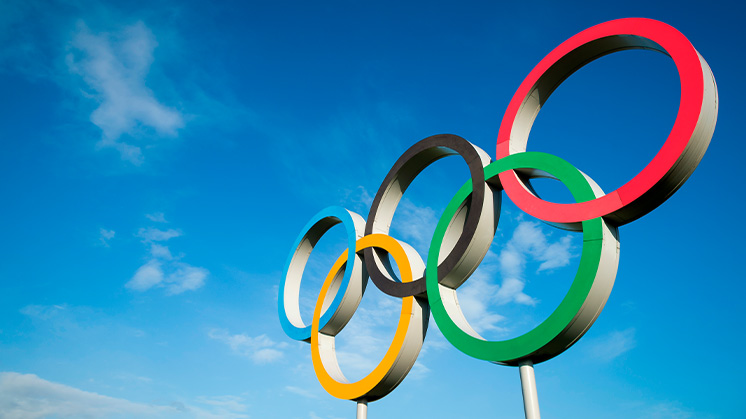10 interesting facts about the Olympics
10 interesting facts to learn about the history and tradition of the Olympics
Every four years the most important sporting event in the world is held: the Olympics, an event full of interesting anecdotes that reveal the rich history of this competition whose origins date back to 776 BC in Ancient Greece. Here are 10 tidbits to find out more about its main elements, from the symbolism of the lighting of the torch to the meaning of the Olympic rings.

For every new Olympics, the world prepares to witness a sporting event like no other. From its birth in Ancient Greece to its evolution to the competitions of today, this celebration has borne witness to major events in sport, always rooted in a tradition that has its origins in the past. In this article we’ll discover 10 interesting facts that explain why this celebration of sport is unique.
Top 10 things you may not know about the Olympics
 An ancient event
An ancient event
According to historical records, a major sporting event was recorded as early as 776 BC in the ancient Greek city of Olympia, which is where the current games’ name comes from. The competitions were an integral part of the Hellenic culture of the time, taking on an important religious and cultural significance as the contests were related to honouring the god Zeus. At first, they only included events like foot races and a pentathlon divided into a foot race, long jump, discus throw, javelin throw and wrestling, and athletes usually competed naked.
 The Olympic rings and their significance
The Olympic rings and their significance
One of the main emblems of the sporting event and a symbol of peace, the Olympic rings represent the union of the five continents (Oceania, Africa, America, Asia and Europe) through the representation of five different coloured rings intertwined. The design was conceived by Pierre de Coubertin, founder of the Olympic movement, who decided to use those colours (blue, yellow, black, green and red) because every nation has at least one of them on its flag.
The Olympic flag, which consists of the five rings on a white background, came into being at the 1914 World Congress in Paris, but it was not until the 1920 event in Antwerp, Belgium, that it was officially hoisted for the first time. Since then, it has been at every Olympic celebration.
 The lighting of the Olympic torch, the highlight of the event
The lighting of the Olympic torch, the highlight of the event
Along with the Olympic rings, the torch is one of the Olympics’ main symbols. It all starts months before the big event at the Temple of Hera in the archaeological remains of Olympia. In a ceremony symbolising the connection between the ancient and the modern, an Olympic flame is lit and the torch is carried past thousands of people to the host city for the lighting of the Olympic cauldron on the opening day.
According to protocol, the flame must continue to burn for the duration of the event until the day of the closing ceremony, when it is put out for the Olympic period to be considered officially over.
 The history behind the podiums
The history behind the podiums
It was the 1912 games in Stockholm, Sweden that inaugurated the podium at the awards ceremonies. In previous competitions, the winners of each of the disciplines simply received their medals on the same level as the other competitors.
The ritual of stepping onto the podium to receive the medals was to let the public and the media see them better, and it turned into a symbolic and iconic moment for many athletes. American swimmer Michael Phelps has done it the most in history, winning a total of 28 Olympic medals (23 gold, three silver and two bronze) in his career.

High-performance athletes
Normal people or extraordinary beings?

Sustainability comes to the world of sport
Sustainable sport seeks to reduce the sport's ecological footprint on the environment.

Veteran athletics is going strong
Veteran athletics continues to break records in terms of the number of licences.
 The first medals were not made of gold
The first medals were not made of gold
Athletes at the 1906 St. Louis games were the first to receive gold, silver and bronze medals for first, second and third place. Before that, gold medals were not produced for the competition as it was an expensive material, so the event organisers opted for a different metal: in Athens 1896 the first-placed athletes received a silver medal, an olive branch and a diploma, while the second-placed athletes received a copper medal, a laurel branch and a diploma.
 The symbolism of the mascots
The symbolism of the mascots
Izzy, Cobi, Misha are just some of the names that have marked the history of these sporting competitions held every four years. And we’re not talking about record-breaking athletes, we’re talking about the Olympic mascots, icons for each games.
They were officially created in Munich in 1972 with the dachshund Waldi, one of the most popular mascots to this day. Its initial purpose was to cheer on the athletes before each competition and get the crowd fired up, as well as to symbolise Olympic values with its attributes such as endurance, tenacity and agility. One interesting fact is that Waldi's design was conceived with three of the six colours of the Olympic flag (blue, yellow and green), and that the dog was shaped like that year's marathon course.
 1960: the first Olympics to be broadcast live on television
1960: the first Olympics to be broadcast live on television
A milestone that marked the beginning of a new era in the Olympics was the start of live television broadcasting, which was first introduced in London in 1948, although very few people had televisions. The simple fact of bringing the competitions to a large number of viewers made a major contribution to the spread of the Olympic spirit. Colour broadcasting was introduced years later at Tokyo 1964.
 Paris 2024, a record event for gender parity
Paris 2024, a record event for gender parity
The presence of female athletes in Olympic competitions has always been very uneven, but important achievements are being made in many respects. 2012 London, for example, marked a turning point in history as it was the first in which all countries had at least one female athlete on their teams.
Twelve years later, another milestone in terms of Olympic equality has been reached: Paris 2024 will be the first event with full gender parity, with the same number of spots for both women and men. This is further proof that opportunities for women in sport continue to grow.
 A historic opening on the Seine
A historic opening on the Seine
The opening ceremony of Paris 2024 will be a unique event in the history of the competition. For the first time, the traditional parade marking the official start of the event will not take place at a stadium, but on the Seine, the symbol of the French capital. Each of the 205 delegations will be on a boat that will travel six kilometres along the river to Trocadéro in front of the Eiffel Tower.
 The creation of the refugee team
The creation of the refugee team
In March 2016, the Executive Board of the International Olympic Committee (IOC) made official the creation of the Olympic team of refugee athletes, considered an additional delegation that competes in the different modalities of an Olympics. Introduced for the first time at Rio 2016, this team is composed of athletes who currently have refugee status due to conflict, persecution or other humanitarian crises, whether local or global.
Paris 2024 will see a larger and more diverse refugee team than ever before, with 36 athletes, a significant increase from the 29 at Tokyo 2020 and 11 at Rio 2016. With participation in 12 different sports, there are 23 men and 13 women from countries on three different continents, Africa, the Americas and Asia.




